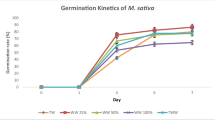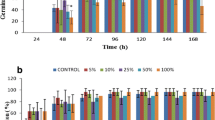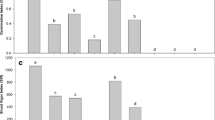Abstract
Brewing industry releases large quantities of wastewater after product generation. Brewery wastewater contains organic compounds which are biodegradable in nature. These biodegradable wastes can be recycled and reused and hence considered as suitable products for agriculture. But before using wastewater for agriculture, it is better to evaluate the phytotoxic effects of wastewater on crops. Hence, the main objective of this study is to evaluate the effects of brewery effluent on seed germination and growth parameters of selected crop species like chickpea (Cicer arietinum), maize (Zea mays), and pigeon pea (Cajanus cajan). Study comprised seven types of water treatments—tap water as control, diluted UASBR effluent (50% effluent + 50% distilled water): UASBR50, undiluted UASBR effluent: UASBR100, diluted TC effluent (50% effluent + 50% distilled water): ETP50,TC effluent without dilution: ETP100, 10% diluted reverse osmosis (RO10) reject (10% RO reject + 90% distilled water), and 25% diluted reverse osmosis(RO25) reject (25% RO reject + 75% distilled water) with three replications in completely randomized design. Germination test was performed in petri plates for 5 days. Parameters like germination percentage, germination rate index, seedling length, phytotoxicity index, seed vigor index, and biomass were calculated. All parameters decreased with increase in respective effluent concentration. Among all treatments, RO25 showed highest inhibitory effect on all three crops. Even though undiluted effluent of UASBR and ETP effluent showed positive effect on germination, seedling growth of three crops was promoted to the maximum by UASBR50 and ETP50. Hence, from the study, it was concluded that dilution of brewery effluent can be recommended before using it for irrigational purpose.






Similar content being viewed by others
References
Abdul-Baki AA, Anderson JD (1973) Vigour determination in soybean by multiple criteria. Crop Sci 3:630–637
Abu-Dieyeh MH, Diab M, Al-Ghouti MA (2017) Ecological and agriculture impacts of bakery yeast wastewater use on weed communities and crops in an arid environment. Environ Sci Pollut Res 24(17):14957–14969. https://doi.org/10.1007/s11356-017-9115-1
Aguirre L, Johnson DA (1991) Influence of temperature and cheatgrass competition on seedling development of two bunchgrasses. J Range Dev 44(4):347–354. https://doi.org/10.2307/4002397
Anupama S (2011) NSL distillery effluent and its effect of paddy crop with various concentrations in Mau, Uttar Pradesh, India. J Environ Res Dev 5(3A):773–778
APHA, AWWA, WEF (2005) Standard methods for the examination of water and wastewater, 21st edn. American Public Health Association, Washington
Asfi M, Ouzounidou G, Moustakas M (2012) Evaluation of olive oil mill wastewater toxicity on spinach. Environ Sci Pollut Res 19(6):2363–2371. https://doi.org/10.1007/s11356-012-0746-y
Augusthy PO, Sherin MA (2001) Effect of factory effluents on seed germination and seedling growth of Vigna radiate L. J Environ Res 22(92):137–139
Barazani O, Golan-Goldhirsh A (2009) Salt-driven interactions between Pistacia lentiscus and Salsola inermis. Environ Sci Pollut Res 16(7):855–861. https://doi.org/10.1007/s11356-009-0231-4
Bazai ZA, Achakzai AKK (2006) Effect of waste water from Quetta city on germination and seedling growth of lettuce (Lactucasativa L.) J Appl Sci 6(2):380–382
Chaitanyakumar D, Unnisa SA, Rao B, Kumar GV (2011) Efficiency assessment of combined treatment technologies: a case study of charminar brewery wastewater treatment plant. Ind J Fund Appl Life Sci 1(2):138–145
da Costa Marques MR, de Souza PSA, Rigo MM, Cerqueira AA, de Paiva JL, Merçon F, Perez DV (2015) Effects of untreated and treated oilfield-produced water on seed germination, seedling development, and biomass production of sunflower (Helianthus annuus L.) Environ Sci Pollut Res 22(20):15985–15993. https://doi.org/10.1007/s11356-015-4820-0
Dash AK (2012) Impact of domestic waste water on seed germination and physiological parameters of rice and wheat. Int J Res Rev Appl Sci 12(2):280–286
Djelal H, Tahrani L, Fathallah S, Cabrol A, Mansour HB (2014) Treatment process and toxicities assessment of wastewater issued from anaerobic digestion of household wastes. Environ Sci Pollut Res 21(4):2437–2447. https://doi.org/10.1007/s11356-013-2158-z
Driessen W, Vereijken T (2003) Recent developments in biological treatment of brewery effluent. The Institute and Guild of Brewing Convention, Livingstone, pp 2–7
Gassama UM, Puteh AB, Abd-Halim MD, Kargbo B (2015) Influence of municipal wastewater on rice seed germination, seedling performance, nutrient uptake, and chlorophyll content. J Crop Sci Biotechnol 18(1):9–19. https://doi.org/10.1007/s12892-014-0091-4
Gautham DD, Bishoni S (1992) Effect of dairy effluent on wheat (Triticumaestivum). J Ecobiol 4:111–115
Genner C (1988) Treatment and disposal of brewery effluents. Brewers Guardian, pp 25–27
Ishiwaki N, Murayama H, Awayama H, Kanauvhi O, Sato T (2000) Development of high value uses of spent grain by fractionation technology. MBAA Technic 37(2):261–265
Khan MG, Danlel G, Konjit M, Thomas A, Eyasu SS, Awoke G (2011) Impact of textile waste water on seed germination and some physiological parameters in pea (Pisumsativum L.), Lentil (Lensesculentum L.) and gram (Cicerarietinum L. ). Asian J Plant Sci 10:269–273
Khan MHU, Khattak JZK, Jamil M, Malook I, Khan SU, Jan M, Din I, Saud S, Kamran M, Alharby H, Fahad S (2017) Bacillus safensis with plant-derived smoke stimulates rice growth under saline conditions. Environ Sci Pollut Res 24(30):23850–23863. https://doi.org/10.1007/s11356-017-0026-y
Lafragueta C, Garcia-Criado B, Arranz A, Vazquez-de-Aldana BR (2014) Germination of Medicago sativa is inhibited by soluble compounds in cement dust. Environ Sci Pollut Res 21(2):1285–1291. https://doi.org/10.1007/s11356-013-2009-y
Lauchli A, Luttge U (2000) Salinity—environments-plants molecules. Kluwer Academic Publishers, Dordrecht
Leal K, Chacin E, Behling E, Gutierez E, Fernandez N, Forster CF (1998) A mesophilic digestion of brewery wastewater in an unheated anaerobic filter. Bioresour Technol 65(1–2):51–55. https://doi.org/10.1016/S0960-8524(98)00025-X
Malaviya P, Sharma A (2011) Impact of distillery effluent on germination behaviour of Brassica napus L. J Environ Biol 32(1):91–94
Mathur KC, Sukla UM, Sukla AK, Shubhi M (1997) Effect of fly ash pollution and growth of maize. J Environ Pollut 4(1):17–27
Mekki A, Dhouib A, Sayadi S (2007) Polyphenols dynamics and phytotoxicity in a soil amended by olive mill wastewaters. J Environ Manag 84(2):134–140. https://doi.org/10.1016/j.jenvman.2006.05.015
Mensuh JK, Akomeah PA, Ikhajiagbe B, Ekpekurede EO (2006) Effects of salinity on germination, growth and yield of five groundnut genotypes. Afr J Biotechnol 5(20):1973–1979
Moll M, Bieres (1991) Coolers—definition, fabrication, composition. Technol Dev 2:15–263
Mseddi S, Chaari L, Belaid C, Chakchouk I, Kallel M (2016) Valorization of treated olive mill wastewater in fertigation practice. Environ Sci Pollut Res 23(16):15792–15800. https://doi.org/10.1007/s11356-015-4353-6
Naeem F, Ahmed F, Kanwal M, Murad W, Azizullah A (2015) Phytotoxicity evaluation of some commonly used shampoos using Brassica napus L. Environ Sci Pollut Res 22(19):15164–15170. https://doi.org/10.1007/s11356-015-5054-x
Nagajyothi PC, Dinakr N, Suresh S, Udaykiran Y, Suresh C, Damodharam T (2009) Effect of industrial effluent on the morphological parameters and chlorophyll content of green gram (Phaseolus aureus Roxb). J Environ Biol 30(3):385–388
Nagda GK, Diwan AM, Ghole VS (2006) Seed germination bioassays to assess toxicity of molasses fermentation based bulk drug industry effluent. Elec J Environ Agric Food Chem 5:1598–1603
Narain K, Bhat MM, Abhilash PC, Yunus M (2012a) Impact of distillery effluent on seedling growth and pigment concentration of Cicer arietinum L. J Environ Res Dev 6(3A):601–608
Narain K, Bhat MM, Yunus M (2012b) Impact of distillery effluent on germination and seedling growth of Pisum sativum L. Univers J Environ Res Technol 2(4):269–272
Naseri R, Emami T, Mirzaei A, Soleymanifard A (2012) Effect of salinity (sodium chloride) on germination and seedling growth of barley(Hordeumvulgare L.) cultivars. Int J Agric Crop Sci 4(13):911–917
Noorjahan CM, Jamuna S (2012) Physico-chemical characterisation of brewery effluent and its degradation using native fungus-aspergillus niger, aquatic plant-water hyacinth-Eichhornia SP and green mussel–Pernaviridis. J Environ Earth Sci 2(4):31–40
Ogunwenmo KO, Oyelana OA, Ibidunmoye O, Anyasor G, Ogunnowo AA (2010) Effects of brewery, textile and paint effluent on seed germination of leafy vegetables—Amaranthus hybridus and Celosia argentea (Amaranthaceae). J Biol Sci 10(2):151–156
Panasker DB, Pawar RS (2011) Effect of textile mill effluent on growth of Vigna unguiculata and Pisum sativum seedlings. Ind J Sci Technol 4(3):266–272
Pandey N, Sharma CP (2002) Effect of heavy metals Co2+, Ni2+, and Cd2+ on growth and metabolism of cabbage. Plant Sci 163(4):753–758. https://doi.org/10.1016/S0168-9452(02)00210-8
Pandey SK, Tyagi P, Gupta AK (2007) Physico-chemical analysis and effect of distillery effluent on seed germination of wheat (Triticum aestivum), pea (Pisum sativum), and lady’s finger (Abelmoschus esculentus). ARPN J Agric Biol Sci 2(6):35–40
Pandey SN, Nautiyal BD, Sharma CP (2008) Pollution level in distillery effluent and its phytotoxic effect on seed germination and early growth of maize and rice. J Environ Biol 29 (2): 267-270
Parawira W, Kudita I, Nyandoroh MG, Zvauya R (2005) A study of industrial anaerobic treatment of opaque beer brewery wastewater in a tropical climate using a full-scale UASB reactor seeded with activated sludge. Process Biochem 40(2):593–599. https://doi.org/10.1016/j.procbio.2004.01.036
Pathak H, Joshi HC, Chaudhary A, Chaudhary R, Kalra N, Dwivedi MK (1999) Soil amendment with distillery effluent for wheat and rice cultivation. Water Air Soil Pollut 113(1–4):133–140. https://doi.org/10.1023/A:1005058321924
Ramana S, Biswas AK, Kundu S, Saha JK, Yadava RBR (2002) Effect of distillery effluent on seed germination in some vegetable crops. Bioresour Technol 82(3):273–275
Rani R, Srivastava MM (1990) Eco physiological response of Pisum sativum and Citrus maxima to distillery effluents. Int J Ecol Environ Sci 16:125–132
Reddy PG, Borse RD (2001) Effect of pulp and paper mill effluent on seed germination and seedling growth of Trigonella foenum-graceum L. (Methi). J Ind Pollut Control 17:165–169
Rodrigues AC, Brito AG, Melo LF (2001) Post treatment of a brewery wastewater using a sequencing batch reactor. Water Environ Res 73(1):45–51. https://doi.org/10.2175/106143001X138679
Rusan MJM, Albalasmeh AA, Zuraiqi S, Bashabsheh M (2015) Evaluation of phytotoxicity effect of olive mill wastewater treated by different technologies on seed germination of barley (Hordeum vulgare L.) Environ Sci Pollut Res 22(12):9127–9135. https://doi.org/10.1007/s11356-014-4004-3
Sandeep K, Pandey SK, Tyagi P, Gupta AK (2007) Physico-chemical analysis and effect of distillery effluent on seed germination of wheat (Triticum aestivum), pea (Pisum sativum), and lady’s finger (Abelmoschus esculentus). ARPN J Agric Biol Sci 2(6):35–40
Senthilraja K, Jothimani P, Rajannan G (2013) Effect of brewery wastewater on growth and physiological changes in maize, sunflower and sesame crops. Int J Life Sci Educ Res 1(1):36–42
Shao X, Peng D, Teng Z, Ju X (2008) Treatment of brewery wastewater using anaerobic sequencing batch reactor (ASBR). Bioresour Technol 99(8):3182–3186. https://doi.org/10.1016/j.biortech.2007.05.050
Singh A, Agrawal SB, Rai JPN, Singh P (2002) Assessment of the pulp and paper mill effluent on growth, yield and nutrient quality of wheat (Triticum aestivum L.) J Environ Biol 28(3):283–288
Wang R (2005) Modeling seed germination and seedling emergence in Winterfat (Krascheninnikovia lanata (Pursh) A.D.J. Meeuse & Smit): Physiological mechanisms and ecological relevance. Ph.D Thesis, University of Saskatchewan, Saskatoon, Saskatchewan.
Wang YR, Yu L, Nan ZB, Liu YL (2004) Vigor tests used to rank seed lot quality and predict field emergence in four forage species. Crop Sci 44(2):535–541. https://doi.org/10.2135/cropsci2004.5350
Yasmin A, Nawaz S, Ali SM (2011) Impact of industrial effluents on germination and seedling growth of lens esculentum varieties. Pak J Bot 43(6):2759–2763
Yousaf I, Ali SM, Yasmin A (2010) Germination and early growth response of Glycine max varieties in textile and paper industry effluents. Pak J Bot 42:3857–3386
Zhang R, Zhang H, Tu C, Hu X, Li L, Luo Y, Christie P (2015) Phytotoxicity of ZnO nano particles and the released Zn (II) ion to corn (Zea mays L.) and cucumber (Cucumis sativus L.) during germination. Environ Sci Pollut Res 22(14):11109–11117. https://doi.org/10.1007/s11356-015-4325-x
Acknowledgements
The author would like to acknowledge Department of Science and Technology, India, for providing fellowship under INSPIRE programme to pursue doctoral study.
Author information
Authors and Affiliations
Corresponding author
Additional information
Responsible editor: Philippe Garrigues
Rights and permissions
About this article
Cite this article
Salian, R., Wani, S., Reddy, R. et al. Effect of brewery wastewater obtained from different phases of treatment plant on seed germination of chickpea (Cicer arietinum), maize (Zea mays), and pigeon pea (Cajanus cajan). Environ Sci Pollut Res 25, 9145–9154 (2018). https://doi.org/10.1007/s11356-018-1218-9
Received:
Accepted:
Published:
Issue Date:
DOI: https://doi.org/10.1007/s11356-018-1218-9




